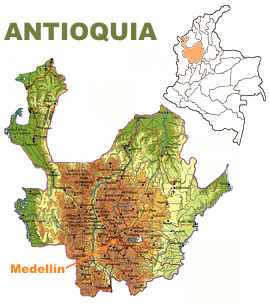If you ever
visit the famous coffee-producing region of Antioquia, Colombia, take care not
to wander beyond theboundaries of the towns or coffee plantations you visit,
especially at night. According to La Patasola legend, you just might encounter
a supernatural creature that will drink your blood for daring to disturb the
peace of the jungle.
You will
see to La Patasola in:
Antioquia
Antioquia,
the land of beautiful women, is one of the prettiest and wealthiest regions in
Colombia.
The
department is located in central-west Colombia and bordered in the north by the
Caribbean Sea and the departments of Córdoba, Sucre and Bolívar. It is bordered
by the departments of Risaralda and Caldas in the south, by Chocó in the west
and by Boyacá and Santander in the east.
The central
and western cordilleras (mountain ranges) cross the department. This fertile
area is ideal for raising livestock and for growing bananas and coffee beans,
which are the two major agricultural productions in the country, as well as a
wide variety of crops such as rice, yucca, sorghum, beans, sugar cane and
cocoa. The area is also rich in bauxite and gold deposits.
Industry,
commerce, mining and agriculture are the main sources of income.
During the
pre-Colombian period, the territory was populated by the Quimbayas and other
Caribbean family native tribes. The Spanish conquest of these beautiful lands
began with the arrival on Quimbayan soil of Rodrigo of Bastidas and Juan de la
Cosa in 1501 and Alonso of Ojeda in 1510. Years later, the region was delimited
and given the name of State of Antioquia. It received the category of
department in 1886.
The
department has an area of 6,612 square kilometers. There are more than 5.5
million people living in this region. Two-thirds of the population live in
urban areas.
The
territory has several parks of national heritage: Paramillo National Natural
Park, shared with the department of Córdoba, Las Orquídeas National Natural
Park and a world heritage place: Los Katios National Park (between Antioquia
and Chocó departments).
It is worth
saying that the most beautiful orchids in the world come from Antioquia.
Capital:
Medellín
Known as
“the city of flowers and eternal spring”, Medellín is the second most important
city in Colombia.
It is
located in the center of the Aburrá Valley and is one of the main commercial
and industrial centers of the country.
This
beautiful place with around 3 million people, is full of splendid gardens,
parks, museums, such as the Museum of Fine Arts, the Zea Museum, where you can
admire the work of many great artist including the paintings and sculptures of
the renowned Medellinense artist Fernando Botero, and the Museum of
Anthropology.
There are
many cultural, skyscrapers, beautiful mansions, commercial centers, amusement
parks, nightclubs and educational centers such as the well-known University of
Antioquia, the National University, the University of Medellín and the
Pontifical Bolivariana University.
Medellín
has the most modern transportation system in Colombia. There is a city train
(The Metro of Medellín) and the amazing Cable Metro that transports thousands
of citizens every day.
Nutibara
Hill is known as the "breathing area" of the city and it is where the
Pueblito Paisa (a replica of colonial-period Antioquian village) is found.
The city
has been the birthplace of famous writers, intellectuals, politicians, artists,
and successful businessmen.
Tolima Grande
Tolima
Grande is a region of Colombia understood by the departments of Tolima and
Huila. Also part of the Caqueta region, as most of its inhabitants are
descendants of Huila and Tolima due to colonization that occurred between the
nineteenth and twentieth century and has continued until now. Its main cities
are Ibagué, Neiva, Espinal, Pitalito and Florencia. The adjective of its
inhabitants is "opita".
This part
of the country is among the central and eastern mountain ranges, separated both
by the Magdalena river which rises in the department of Huila. In this
department you can also find varied landscapes as the Nevado del Huila and the
desert of Tatacoa.
Musically,
this region is rooted bambuco. The capital of Tolima has been declared the
musical city of Colombia, as their conservatory is one of the largest in the
country.
La Patasola Today
While the
cultural message of the legend of La Patasola legend may not have as much
relevance today when all kinds of sexual behaviors seem permissible, it is
still a core part of Colombian folklore.
If you want
to meet La Patasola without risking your life, you can visit the Path of Myths
and Legends at the National Coffee Park in Montenegro, Colombia, or attend the
annual Myths and Legends parade in early December in Medellín, Colombia to get
in touch with true Latin American legends.






No hay comentarios.:
Publicar un comentario